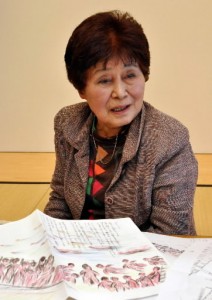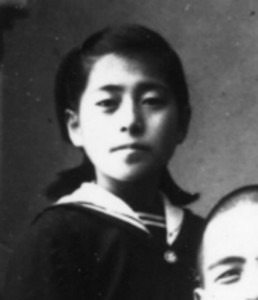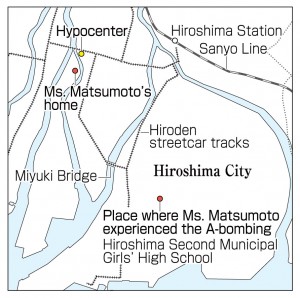Survivors’ Stories: Hideko Matsumoto, 86, Kure City
Apr. 4, 2016
Lost six members of her family to the A-bomb
by Yuji Yamamoto, Staff Writer
Even now, Hideko Matsumoto (née Kita), 86, who once lived in Zaimoku-cho (now part of Naka Ward), still cringes with fear when she sees the numbers “eight” and “six” together. On August 6, 1945, she lost six members of her family to the atomic bombing and could not even be present at their final moments. She views the Hiroshima Peace Memorial Park, which was created on the ground where her house had stood, as a hallowed grave where her family now sleeps.
At the time of the atomic bombing, Ms. Matsumoto was 15 and a second-year student at Hiroshima Second Municipal Girls’ High School (now Funairi High School). Around 7 a.m. on August 6, she left home with her lunch box prepared by her mother, Yoshie, to go to school, located in Midori-machi (now part of Minami Ward), about 3.2 kilometers from the hypocenter.
While chatting with friends in her classroom, she was bathed in a flash of orange light and dove under a desk. Several seconds later, she stood up to flee, and then came a tremendous blast. She was stabbed by glass fragments from the shattered windows on the right side of her body. Though she hurried to the air-raid shelter that had been dug in the ground of the school and waited for the situation to settle down, there were no instructions from the school staff. Another student said that something terrible had happened in Hiroshima, and Ms. Matsumoto decided to return home.
Along the way, she saw many wounded victims pleading for water. Miyuki Bridge was teeming with people in tattered clothes, their hair disheveled. These were scenes from hell, she said. Raging flames and smoke blocked her way, and she headed to Koi-cho (now part of Nishi Ward), where her classmate’s house was located.
Around 3 p.m., Ms. Matsumoto finally ate lunch at her friend’s home, but she was very worried about the safety of her family. She spent that night, without a wink of sleep, at the home of an acquaintance in Koi-cho. The city center continued to burn through the night.
On the following day, August 7, she reached Zaimoku-cho, which had been one of the liveliest parts of the city, but the area was now charred ruins all around. She was overwhelmed by indescribable grief and began to weep. On August 8, when the fires died out, she returned to the place where her home had stood and found two human skeletons in the entrance hall and the kitchen. She put some of the bones in a tea canister and carried it with her.
Of the ten members of her family, only four people survived: Ms. Matsumoto; her father, Kakichi, who had gone to Nakahiro-cho (now part of Nishi Ward) to deliver food; and her sister and brother, who were evacuated earlier, along with their classmates, to Mirasaka-cho (now part of the city of Miyoshi) in the event that the city became a target of air raids.
She does not know what became of her mother, 40, and her sister, 17, who had left home to work for the Chugoku Shimbun, located in Kami Nagarekawa-cho (now part of Naka Ward), her brothers, 7 and 2, and her sister, 4. Her sister, 13, went to help tear down buildings to create a fire lane around Dobashi-cho (now part of Naka Ward), and Ms. Matsumoto found her burnt and torn blouse near the Tenma River. She believes that her sister had taken off the smoldering blouse and plunged into the water.
She moved to Ondo-cho (now part of the city of Kure), her mother’s hometown, and began to live with her brother and sister who had returned from their evacuation site in the countryside. Her father’s hair fell out and he lost his teeth when his gums eroded, thus taking on the appearance of a much older man. Still, he managed to find a job and earn money. He went on fighting his A-bomb illness until he died in 1960 at the age of 58.
There were many people, including her mother’s siblings and Masamitsu, the man she married in 1955, who were kind to her and helped her overcome the horror of the atomic bombing.
After television began broadcasting in Japan in 1953, Ms. Matsumoto would watch the TV screen carefully, thinking she might spot her missing family members. She was unable to accept that they had died and hoped that they were, in fact, still alive somewhere.
Today, Ms. Matsumoto enjoys singing in a chorus, an activity she began about 10 years ago. The songs, she said, bring together the hearts of the chorus group. She thinks, too, about her elder sister, who loved to sing. When she goes to the Peace Memorial Park, she unfailingly visits a stone monument with the inscription “Former Zaimoku-cho.” The monument stands inconspicuously in the park, and she strokes it with her hand and says to her loved ones, “I’m here again.” She hopes that people all over the world will visit the park and pray for peace and that such prayers will spread around the earth.
Teenagers’ Impressions
Hard to accept the death of loved ones
When I heard that Ms. Matsumoto was looking for her mother and her siblings on TV and in the newspaper, I was really struck by how much she loved her family. It must be difficult to accept the death of family members when there isn’t a chance to see the bodies. Her last memories with them had to have been so painful. She was able to convey the hate she feels for nuclear weapons and war very clearly. (Hiromi Ueoka, 15)
Praying at the monument, reflecting on the past
Peace Memorial Park is like a family grave for her, a place where she thinks about them and talks to them. We mustn’t forget that there were people living in that area right up until the atomic bomb was dropped. I plan to visit the park, while imagining the town back then and the people’s lives in those days, and pray for a peaceful world along with others putting their hands together in prayer. (Kohei Furohashi, 16)
Staying close to family and friends
Again and again, Ms. Matsumoto said, “I hope that people all over the world will come together and unite.” There are many ways to do this, such as singing songs as a group and praying for peace across national borders. As Ms. Matsumoto said, one basic and important way is simply sharing meals together with your family. I’m grateful that I have family and friends and I want to stay close to them. (Moe Nakano, 17)
(Originally published on April 4, 2016)
by Yuji Yamamoto, Staff Writer
Even now, Hideko Matsumoto (née Kita), 86, who once lived in Zaimoku-cho (now part of Naka Ward), still cringes with fear when she sees the numbers “eight” and “six” together. On August 6, 1945, she lost six members of her family to the atomic bombing and could not even be present at their final moments. She views the Hiroshima Peace Memorial Park, which was created on the ground where her house had stood, as a hallowed grave where her family now sleeps.
At the time of the atomic bombing, Ms. Matsumoto was 15 and a second-year student at Hiroshima Second Municipal Girls’ High School (now Funairi High School). Around 7 a.m. on August 6, she left home with her lunch box prepared by her mother, Yoshie, to go to school, located in Midori-machi (now part of Minami Ward), about 3.2 kilometers from the hypocenter.
While chatting with friends in her classroom, she was bathed in a flash of orange light and dove under a desk. Several seconds later, she stood up to flee, and then came a tremendous blast. She was stabbed by glass fragments from the shattered windows on the right side of her body. Though she hurried to the air-raid shelter that had been dug in the ground of the school and waited for the situation to settle down, there were no instructions from the school staff. Another student said that something terrible had happened in Hiroshima, and Ms. Matsumoto decided to return home.
Along the way, she saw many wounded victims pleading for water. Miyuki Bridge was teeming with people in tattered clothes, their hair disheveled. These were scenes from hell, she said. Raging flames and smoke blocked her way, and she headed to Koi-cho (now part of Nishi Ward), where her classmate’s house was located.
Around 3 p.m., Ms. Matsumoto finally ate lunch at her friend’s home, but she was very worried about the safety of her family. She spent that night, without a wink of sleep, at the home of an acquaintance in Koi-cho. The city center continued to burn through the night.
On the following day, August 7, she reached Zaimoku-cho, which had been one of the liveliest parts of the city, but the area was now charred ruins all around. She was overwhelmed by indescribable grief and began to weep. On August 8, when the fires died out, she returned to the place where her home had stood and found two human skeletons in the entrance hall and the kitchen. She put some of the bones in a tea canister and carried it with her.
Of the ten members of her family, only four people survived: Ms. Matsumoto; her father, Kakichi, who had gone to Nakahiro-cho (now part of Nishi Ward) to deliver food; and her sister and brother, who were evacuated earlier, along with their classmates, to Mirasaka-cho (now part of the city of Miyoshi) in the event that the city became a target of air raids.
She does not know what became of her mother, 40, and her sister, 17, who had left home to work for the Chugoku Shimbun, located in Kami Nagarekawa-cho (now part of Naka Ward), her brothers, 7 and 2, and her sister, 4. Her sister, 13, went to help tear down buildings to create a fire lane around Dobashi-cho (now part of Naka Ward), and Ms. Matsumoto found her burnt and torn blouse near the Tenma River. She believes that her sister had taken off the smoldering blouse and plunged into the water.
She moved to Ondo-cho (now part of the city of Kure), her mother’s hometown, and began to live with her brother and sister who had returned from their evacuation site in the countryside. Her father’s hair fell out and he lost his teeth when his gums eroded, thus taking on the appearance of a much older man. Still, he managed to find a job and earn money. He went on fighting his A-bomb illness until he died in 1960 at the age of 58.
There were many people, including her mother’s siblings and Masamitsu, the man she married in 1955, who were kind to her and helped her overcome the horror of the atomic bombing.
After television began broadcasting in Japan in 1953, Ms. Matsumoto would watch the TV screen carefully, thinking she might spot her missing family members. She was unable to accept that they had died and hoped that they were, in fact, still alive somewhere.
Today, Ms. Matsumoto enjoys singing in a chorus, an activity she began about 10 years ago. The songs, she said, bring together the hearts of the chorus group. She thinks, too, about her elder sister, who loved to sing. When she goes to the Peace Memorial Park, she unfailingly visits a stone monument with the inscription “Former Zaimoku-cho.” The monument stands inconspicuously in the park, and she strokes it with her hand and says to her loved ones, “I’m here again.” She hopes that people all over the world will visit the park and pray for peace and that such prayers will spread around the earth.
Teenagers’ Impressions
Hard to accept the death of loved ones
When I heard that Ms. Matsumoto was looking for her mother and her siblings on TV and in the newspaper, I was really struck by how much she loved her family. It must be difficult to accept the death of family members when there isn’t a chance to see the bodies. Her last memories with them had to have been so painful. She was able to convey the hate she feels for nuclear weapons and war very clearly. (Hiromi Ueoka, 15)
Praying at the monument, reflecting on the past
Peace Memorial Park is like a family grave for her, a place where she thinks about them and talks to them. We mustn’t forget that there were people living in that area right up until the atomic bomb was dropped. I plan to visit the park, while imagining the town back then and the people’s lives in those days, and pray for a peaceful world along with others putting their hands together in prayer. (Kohei Furohashi, 16)
Staying close to family and friends
Again and again, Ms. Matsumoto said, “I hope that people all over the world will come together and unite.” There are many ways to do this, such as singing songs as a group and praying for peace across national borders. As Ms. Matsumoto said, one basic and important way is simply sharing meals together with your family. I’m grateful that I have family and friends and I want to stay close to them. (Moe Nakano, 17)
(Originally published on April 4, 2016)










